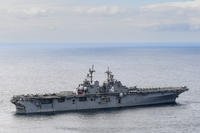
The U.S. Air Force -- plagued by a recent series of F-15 fighter crashes and the loss of a B-2 stealth bomber -- is fighting to maintain its approved force levels and to move forward with several aircraft programs. And, the Air Force has initiated a controversial move into Unmanned Aerial Vehicles.
In the fiscal year 2009 budget request the Air Force is asking for $117 billion to sustain the existing force, modernize the force, and provide for increasing personnel costs. The request is up $8.6 billion, or roughly eight percent, compared to the $108.4 billion that Congress provided for the Air Force in the current fiscal year. That amount may not be enough to maintain and modernize the 86 combat wings that Air Force officials refer to as the "required force."
The increasing costs of fuel and the invariably higher-than-predicted costs of new aircraft threaten the force level unless Congress provides additional funds. But the Army and Marine Corps, both being expanded and both suffering major material problems after several years of conflict in Afghanistan and Iraq, and the Navys massive ship cost problems make a substantial increase for Air Force programs unlikely.
Of the several aircraft programs being discussed the most critical in the view of senior Air Force commanders is the F-22 Raptor, the "next generation" stealth fighter aircraft. The Department of Defense has approved only four more F-22s after the fiscal 2009 budget which would provide a total of 187 aircraft. Previously the Pentagon has stonewalled buying more F-22s when Air Force studies indicated that at least 250 are needed with a goal of 381 aircraft. Deputy Secretary of Defense Gordon England has written that "in depth" reviews by the Pentagon show that buying F-35 Lightning II multi-role aircraft for the Air Force, Navy, and Marine Corps "provides more effective capability to the joint force commander than concentrating investments in a single service by buying more F-22s."
There are 20 F-22 aircraft in the fiscal 2009 budget, which reaches the 183 number (the 20 being part of a three-year, 60-aircraft multiyear contract). The four aircraft provided under Mr. Englands plan enable the Lockheed Martin production line to remain (barely) open until a key decision point in early 2009, when the new administration could make the decision about continuing F-22 production.
Beyond the F-22 issue, the Air Force is seeking more C-17 Globemaster III cargo aircraft (although none are provided in the basic fiscal 2009 budget request) while the forthcoming tanker aircraft procurement and the initiation of a new bomber aircraft will also demand more funding. And, there is the UAV issue. Of the 93 aircraft requested in the Air Forces fiscal 2009 budget, more than half are unmanned aerial vehicles:
20 F-22 Raptor
8 F-35 Lightning II
6 CV-22 Osprey
4 MC-130 Combat Talon (Hercules)
2 HC-130 Hercules
1 C-29A
52 UAV
The unmanned aircraft are: 38 MQ-1B armed Predators, 9 MQ-9 Reapers (Predator B), and 4 RQ-4 Global Hawks.
Meanwhile, the Air Force and Army have agreed to cooperate on procuring and supporting Predator and Sky Warrior UAVs, which is expected to save money for both services. But the Air Force is concerned that the Army is using "software" to fly its UAVs as opposed to trained aircraft pilots, as does the Air Force. The Air Force does use non-pilots for controlling micro-UAVs (similar to the Army's five-pound Raven, which are used for base security functions). The Air Force uses rated pilots for the larger UAVs, being concerned about mission flexibility and the potential for collisions with other UAVs or manned aircraft.
The Air Force is expanding its UAV qualification and training programs, with a major effort underway to increase the number of pilots being transferred to UAV programs. The Army -- which uses mainly warrant officers as pilots for its thousands of helicopters -- cannot provide rated pilots to man the planned force of several hundred UAVs.
Thus, the Air Force is facing major challenges in several important areas.








